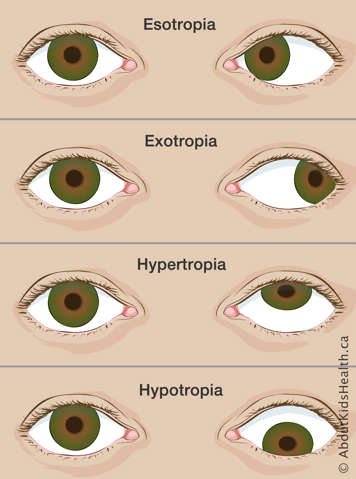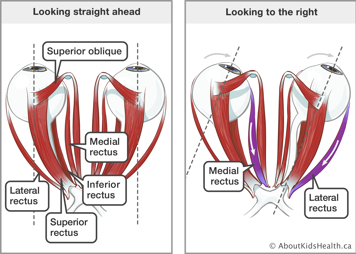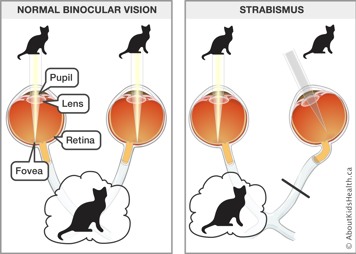What is strabismus?

Strabismus (say: struh-BIZ-mus) is a condition where your child's eyes are not straight. One eye may be:
- turned in (esotropia, also called "cross eyed")
- turned out (exotropia, also called "wall eye")
- too high (hypertropia) compared to the other eye
- too low (hypotropia) compared to the other eye
How the eyes work together
The movements of the eyes up and down and from side to side are controlled by six muscles attached to the outside of the eyeball. When the eyeball turns, one muscle pulls while the opposite muscle relaxes. The muscles are positioned in a way that keeps the eyes parallel (straight) as they move together in all directions.

What happens when the eyes do not work together
Most people can look at an object with both eyes at the same time. This is called normal binocular vision (seeing with both eyes). Children with strabismus have a problem with binocular vision. They cannot use both eyes normally at the same time because the eyes are pointing in different directions.

Fine vision, called visual acuity (say: ak-YOO-it-ee), usually remains normal in each eye if the eyes take turns looking at things. However, if your child prefers just one eye all the time, the vision in the other eye may not develop properly. This decreased vision is called amblyopia or "lazy eye".
Causes of strabismus
Your child's strabismus can have several possible causes:
- weakened eye muscles
- abnormal nerve control of the eye muscles
- heredity (inheriting strabismus from a parent, aunt or uncle)
- blurred or poor vision in one or both eyes
- cataract (clouding of the lens)
- a neurological condition (a condition that affects the nerves)
Treatment for strabismus
The treatment for strabismus is different for each child, depending on their vision problem and its cause. In general, treatment aims to:
- preserve, improve or restore (bring back) your child's vision
- straighten the eyes
- help the eyes work together
Treatment can include patching, eye glasses, eye drops, eye exercises and surgery. Your doctor will explain what type of treatment is best for your child.
Patching
When strabismus results in amblyopia, or "lazy eye", the most common treatment is to apply a patch over the stronger eye. This is called occlusion (say: uh-KLOO-zhun) therapy and will help to strengthen the vision in the lazy eye. Patching one eye, or each eye in turn, can sometimes treat strabismus even if your child does not have amblyopia.
Your doctor will explain how often to apply the patch and how long your child will need it. The doctor will check your child often to see if the treatment is working.
Eye glasses
Your child may need glasses to help the eyes work together, to improve their vision, or both. Eye glasses will only work if your child wears them all the time when they are awake.
Eye drops
In some cases, the doctor may prescribe special eye drops to blur the vision in the stronger eye. This makes the lazy eye work harder. It is very important to put in the eye drops correctly.
Eye exercises
In specific cases, eye exercises may help the eyes move together better. Your doctor will tell you if your child needs to do these exercises.
Surgery
If eye glasses and patching are not enough to straighten your child's eyes, your child may need strabismus surgery. This surgery is designed to straighten the eyes, but it does not replace patching or eye glasses. For more information, please call the doctor who saw your child.
Please write your doctor's name and phone number here.
Dr. ________________________ Phone: _____________________